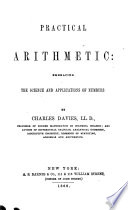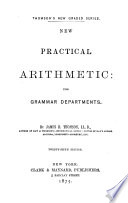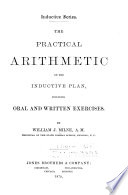 | Charles Davies - Algebra - 1860 - 412 pages
...being obliged to find all the terms which precede it. That is, Any term of a geometrical progression is equal to the first term, multiplied by the ratio raised to a power whose exponent denotes the number of preceding terms. EXAMPLES. 1. Find the 5th term of the progression... | |
 | William Smyth - 1861 - 352 pages
...and let the ratio be represented by q; from the nature of the progression, we have, it is evident, from which it will be readily inferred, that a term...number of this term; from what has been said, we have This is called the general term of the progression. By means of it we may find any term required, when... | |
 | Charles Davies - Arithmetic - 1861 - 496 pages
...term, 3x3x4=; 36, 3d term. 3X3X3X4 = 108, 4th term. 3x3x3x3x4 = 324, 5th term. Therefore, the last term is equal to the first term multiplied by the ratio raised to a power whose exponent is 1 less lhar the number of terms. Rule. — Raise the ratio to a power whoxe exponent... | |
 | Charles Davies - Arithmetic - 1866 - 356 pages
...6, 2d term, 3x2x2 = 3x2' = 12, 3d term, 3x2x2x2 = 3x2* = 24, 4th term, &c. Therefore, the last term is equal to the first term multiplied by the ratio raised to a power 1 less than the nu-nber of Rule. — Raise the ratio to a power whose exponent is 1 lens than the number... | |
 | James Bates Thomson - 1875 - 392 pages
...2), 3 x (2 x 2 x 2 x 2), etc. Or 3, 3X2, 3 x 2'2, 3 x 23, 3 x 24, etc. That is, Each successive term is equal to the first term multiplied by the ratio raised to a power whose index is one less than the number of the term. Hence, the KULE. — Multiply the first term ly... | |
 | William James Milne - Arithmetic - 1877 - 402 pages
...X 2-, the fourth 3 X 22 X 2 or 3 X 23 and " ' ' the fifth 3X23X2 or 3 X 2<, that is, the fflh term is equal to the first term multiplied by the ratio raised to the fourth power. RULE. — Any term of a geometrical progression is equal to the first term, multiplied... | |
 | William James Milne - Algebra - 1892 - 370 pages
...or wth term, I. I = ar—1. That is, 356i PRINCIPLE. — The last term of a geometrical progression is equal to the first term, multiplied by the ratio raised to a power whose index is 1 less than the number of terms. EXAMPLES. 1. Find the 8th term of the series 2, 4,... | |
 | William James Milne - Arithmetic - 1892 - 440 pages
...22, the fourth 3 x 22 x 2 or 3 x 2», and the fifth 3 x 2« x 2 or 3 x 24, that is, the fifth term is equal to the first term multiplied by the ratio raised to the fourth power. RULE. — Any term of a geometrical progression is equal to the first term, multiplied... | |
 | John Tilden Prince - Arithmetic - 1894 - 246 pages
...upon the above numbers, the following rules may be developed : The last term of a geometrical series is equal to the first term multiplied by the ratio raised to a power whose degree is one less than the number of terms. The first term is equal to the last term divided... | |
 | William James Milne - Algebra - 1906 - 444 pages
...last or nth term, I. l=arn~1. That is, 356. PRINCIPLE. — The last term of a geometrical progression is equal to the first term, multiplied by the ratio raised to a vower whose index is 1 less than the number of terms. EXAMPLES. 1. Find the 8th term of the series... | |
| |